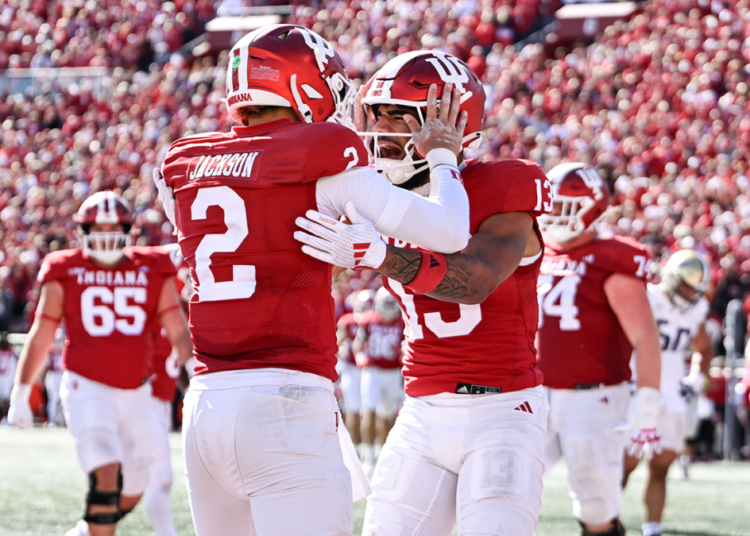November tends to be the defining stretch of every college football season. Injuries pile up. Conference races shift. But it’s also a jumping off point for College Football Playoff contention. Teams have these next 30 days to make an impression with conference championship games kicking off the first weekend in December.
The reason the BCS was scrapped and replaced with the College Football Playoff in 2014 in the first place was access and interest. Both factors increased, meaning you could largely label the playoff system as a success — at least to this point.
But there is a hidden number beyond playoff spots as we enter November and the debut of the 12-team format looms. It is the number of teams that find themselves in legitimate contention for a playoff spot heading into Week 10.
That number hovers around 45-50 teams, according to CBS Sports Research. We were extremely inclusive and subjective, but two things …
- So is the CFP process itself. Have we forgotten the BCS computer math was scrapped in favor of humans 11 years ago?
- The men who developed the expanded playoff basically agree that almost 40% of the field still have a chance heading into November.
CBS Sports was able to reach three of the four administrators responsible this week.
“My memory isn’t that good, but that number [45-50] feels pretty consistent with our research at the time,” said former Notre Dame AD Jack Swarbrick. “We looked at both poll movement over the entire course of the season and conference records on a weekly basis to see who might still qualify for the conference championship games. That analysis played a significant role in causing us to recommend the 12-team model.”
While the process remains subjective, the number of teams still in contention reflects the intent of the expanded field. More talk, more publicity, more interest, more access, more teams.
In addition to Swarbrick, architects of the 12-team CFP include former Big 12 commissioner Bob Bowlsby, SEC commissioner Greg Sankey and former Mountain West commissioner Craig Thompson.
In June 2021, Bowlsby estimated that 30-35 teams would be in the running on Nov. 1.
At the time, that number seemed optimistic. Not anymore.
“We knew that the number would be large most years, making the second half of the season very exciting,” Bowlsby told CBS Sports this week. “The TV ratings will be excellent. I am sure we will get thank you notes from all of the networks!”
Whether those thank you notes go out or not, ratings are up. ESPN executive Burke Magnus recently tweeted the 3:30 pm ET window on the network is up 85% with the addition of the SEC. The Ohio State-Oregon game two weeks ago marked the largest primetime audience for a Big Ten game in 16 years. CBS had the No. 1 rated game of the day with Michigan vs. USC in Week 4.
“There was never really a projected number, but to have that many teams still in contention for one of the 12 spots this late in the season was definitely the intention,” Thompson said. “It’s fantastic that the interest and passion of college football continues to grow.”
The fact that some games toward the end of the season may be for seeding hasn’t diminished interest. For example, last week CBS Sports noted six matchups that could be played three times this season.
You bored? Of course not. One game not listed last week was No. 4 Ohio State vs. No. 3 Penn State — a matchup that’s in the featured spot of the Week 10 schedule. Unless the sky falls, both teams have a good chance to get to the CFP.
Teams don’t have to win their conference to play for a national championship, which is a huge change. In the BCS era, only five of the 72 berths have been occupied by at-large teams since 1998.
In addition to the five automatic qualifiers (top five-ranked conference champions), there will seven at-large spots per year.
Here is a categorization of contenders heading into Week 10. If you disagree, stick around, because things are sure change.
- Locks: Miami, Indiana, Oregon, Penn State, Georgia, Texas
- Probable: Tennessee, Boise State, Clemson, BYU/Iowa State/Kansas State (Big 12 champion), Notre Dame, Ohio State, Texas A&M
- Better Than Expected: SMU, Pittsburgh, Army, Navy, Illinois, UNLV, LSU
- Still Not Dead: Tulane, Memphis, Colorado, Western Kentucky, Liberty, Colorado State, Louisville, Syracuse, Duke, Ole Miss
- On The Fringe: Virginia Tech, Sam Houston, Western Michigan, San Jose State, Arizona State, Iowa, Jacksonville State, Fresno State, Missouri, Vanderbilt, Louisiana-Monroe, Washington State, Texas Tech, Cincinnati, Arizona State
Week 10 storylines
Health questions abound in Ohio State vs. Penn State: Nittany Lions quarterback Drew Allar is a game-time decision against Ohio State with what looks like a left knee injury suffered against Wisconsin. But perhaps just as concerning are apparent injuries to Penn State defensive end Dani Dennis-Sutton and right tackle Anthony Donkoh. That’s a possible three starters out at key positions against the No. 2 defense and a top-10 offense. Meanwhile, the Buckeyes have significant injury issues themselves. Safety Lathan Ransom is day-to-day with an unspecified injury. Left tackle Josh Simmons was lost to a season-ending knee injury against No. 1 Oregon. His backup, Zen Michalski, was carted off the field late in the fourth quarter while making his first career start against Nebraska.
The game will still ride on Ohio State’s superior speed on the perimeter. I don’t usually make picks in this space, but for games of this magnitude, we’ll make an exception: Ohio State 23, Penn State 20
Colorado is back: For all the crap we (the media) have hurled at Coach Prime, it’s time to man up. Deion Sanders has turned around No. 23 Colorado. With more than a month left in the season, the Buffaloes are bowl eligible (6-2) and ranked for the second straight season. By any definition, that’s progress for a program that was 1-11 two years ago. Shedeur Sanders has positioned himself as a top-two quarterback in next year’s draft. Travis Hunter was on the field for a career-high 153 plays against Cincinnati. For his efforts, Hunter became the first player to be named Big 12 offensive and defensive player of the week. The Buffs aren’t completely out of the Big 12 race. Time to gloat, Prime. This time, you would have earned it.
Indiana’s best shot: We’ve mentioned this before, but the No. 13 Hoosiers’ best shot at the playoff right now might be third place in the Big Ten. If Ohio State and Oregon advance to the Big Ten Championship Game, as expected, Indiana would be a dead solid lock at 11-1 for the playoff. Most of all, what if the Buckeyes or the Ducks are going to come out of that game with two losses, assuming Oregon slips somewhere? It will then be up to the committee to decide between Indiana and Penn State for the Nos. 3 and 4 spots from the Big Ten. Indiana travels to Michigan State this week.
Why isn’t Ole Miss better? The Rebels defense has given up eight touchdowns all season (an average of one per game to lead the nation). Prior to this year, Ole Miss defenses have given up 168 touchdowns in 49 games, an average of 3.4 per game. Lane Kiffin was hired for his offensive fireworks. Should we have expected more? Since he arrived in 2020, the Rebels have finished in the top 15 in scoring once. Pro Football Focus rated the offensive line sixth-worst in the country since Week 5. The No. 19 Rebels have to win out to even be considered for a CFP berth in this playoff-or-bust season. The November push starts Saturday at Arkansas.
Louisville might be Clemson’s biggest challenge since Georgia: Remember, the Cardinals went back and forth with No. 5 Miami a couple of weeks ago. It took a comeback from 20 points down last week at Boston College for Louisville to win, but such is the ACC below the Clemson and Miami line. Louisville quarterback Tyler Shough is the third-leading passer in the ACC. The offense is the highest-scoring since 2017. The problem is a defense that isn’t opportunistic. It is tied for second-last nationally in interceptions (two).
Things haven’t been this optimistic around Texas A&M since the Johnny Manziel days: Even then, the No. 10 Aggies didn’t have a shot at the SEC title this late in the season. That said, would anybody be surprised if South Carolina pulled the upset this week? That is, unless Marcel Reed starts.
SMU’s biggest game since the death penalty: A case can certainly be made to that point as No. 18 Pittsburgh comes to town. There’s a reason SMU is (still) raising $250 million so it can live as an ACC member for the next nine years without taking a penny of media rights money. The No. 20 Mustangs are in contention to win the ACC entering Week 10. Even though Miami and Clemson get most of the attention, SMU and Pittsburgh are also undefeated in conference play. The winner lines up nicely for the ACC Championship Game. Pittsburgh controls its destiny meeting Clemson in two weeks.
Quick kicks
Betting odds below via DraftKings Sportsbook. Use DraftKings promo code to get in the game for all of college football’s Week 10 action.
- Michigan (+14.5) is a home underdog for the third time in a season for the first time since 2009 as the Wolverines welcome the top-ranked Ducks. The only other time that happened was 1990.
- Meanwhile, Ducks coach Dan Lanning has never lost a game as a road favorite (11-0). Since 2022, no coach has more straight-up wins as a road favorite.
- Army is a 22-point favorite against Air Force. That’s the largest spread for a service academy game in 21 years.
- Make money: Marshall is the only team in the country undefeated against the spread (7-0). ULM comes to town a 10.5-point underdog.
- Texas A&M is the only team in the nation with two wins vs top-10 teams (No. 9 Missouri, No. 8 LSU).
- Oregon is the only team in the country with three wins vs. bowl-eligible opponents (Boise State, Ohio State, Illinois).
- Let the playoff drumbeat begin in T-Town: Alabama is the only team in the nation with five wins against teams that currently have a winning record (Western Kentucky, Wisconsin, Georgia, South Carolina, Missouri).
Read the full article here



























Discussion about this post